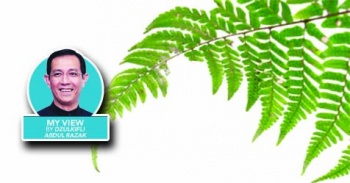The wonders of Aotearoa
Professor Tan Sri Dato' Dzulkifli Abdul Razak
My View - The Sun Daily
April 11, 2017

MANY readers will wonder what Aotearoa is. Most would know it as New Zealand, the “new” (colonial) name attributed to the first European (Dutch) who sailed to the island in the mid-16th century even though he did not set foot on its shores. Initially (re)named Staten Landt, it was later changed to Nova Zeelandia after a Dutch province of Zeeland.
Two centuries later, British explorer James Cook claimed it for Great Britain, and by the late 1700s the first migrant colonial settlement began with an anglicised version of the name. It took root as a British colony when the migrant population swelled. Today 75% of New Zealand’s residents are Europeans.
Lest we forget, the land was already inhabited some 400 years earlier. Aotearoa in the Maori language means the “Land of the long white cloud”.
Tradition has it that white cloud was first sighted by the early Maori navigators as they approached the land mass around the 10th century. The cry “he ao! he ao!” (meaning “a cloud, a cloud”!) was allegedly rendered later to “Aotea-roa” and remains today.
Though this may not be the last word about it, the message is clear – the Maori culture and tradition are an integral part of the country’s history.
With only 15% of the population, the presence of things Maori is everywhere. It ranges from the various Maori names juxtaposed at official buildings, departments, organisations and structures to the myriad decorative arts and designs that adorn them meaningfully.
Be it the tattoo motifs, carvings in wood, (green) stone, shell and bone – all exude the grace to reflect the intimacy of the culture and tradition to the natural environment that inspires them.
It affirms the love for nature to highest level of perfection. Paua, the somewhat oval shaped shell, when radiantly polished as a blue-green multi-coloured ornament serves as a good example, adding distinction as priced export items globally.
To this add the ubiquitous fern or its spiral fronds that has become synonymous with the island nation. Not only is it an appropriate choice to represent the island’s pristine biodiversity, it also serves as a staple food source.
Its availability all the year round makes its consumption, in particular the bracken fern-roots, a cultural heritage passionately preserved by the Maori.
At one time the fern-roots were linked to “fairy-like beings” who were offered the first three roots collected as a sign of respect.
While it is not known how many of the diverse species were used, some are consumed daily till today.
In the world of music, Maori melodies are equally in rhythm with “nature” providing pleasing sound-bites characteristic of Maori songs.
It is said that there is a wealth of “tonal significance within a narrow range” with the “minutest difference in tone”.
These songs were often rendered in harmony with the whole being, body, hands, legs, arms, and facial expression – all gesturing real-life meanings.
So it is with the different types of “songs” as charms, invocations, prayers and incantations better referred to as karakia.
I was privileged to witness its full display during a graduation ceremony last week exquisitely performed in the traditional indigenous style. It was said to be a karakia intoned for knowledge suited to the particular event.
There are others like the haka, made famous by the world renowned Kiwi rugby team – the All Blacks. It is also regarded as another form of song and dance that could be traced way back to the first European encounter or even before that.
The unique dance form now has become an iconic national image beyond just the Maori heritage of a war cry complete with protruding tongue to scare off the enemy. It has turned into a cohesive factor of immense pride among the Kiwis.
Paradoxically it also conveys that peace is no less important to the Maori, accorded to Rongo, who is closely associated with peace-making.
In fact, an enduring peace is rongo taketake marked by the appropriate karakia to indicate the end of hostilities, followed by a ceremonial dance and a great communal feast to boot.
All considered the wonders of Aotearoa is a silver lining to the long white cloud in the Maori-land intimately rooted in knowledge of nature where lives are sustainably immersed.
The knowledge is framed to enhance the trust and responsibility accorded by Mother Nature which is today very often squandered away.
It is a sad reminder of the loss of harmony forged with the forces of nature relegated to the entire land of the long white cloud, and for all times.
Viewed this way there is nothing particularly “new” to New Zealand if not for the longstanding legacy of the Maori that must be preserved and promoted at all cost.
To fellow Malaysians who plan to assemble this weekend under the banner of Kongres Budaya, the stories and successes of the Maori can inspire useful living lessons to learn and reflect on.
Especially so, of late, as Malaysia’s equivalent of the Aotearoa has gradually vanished in cloud nine somewhere!
